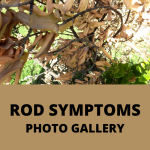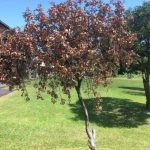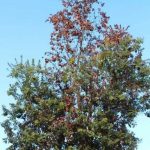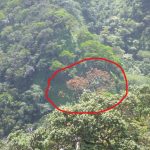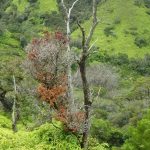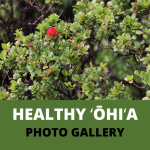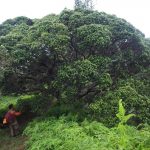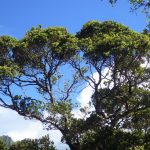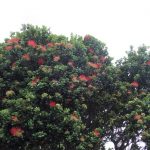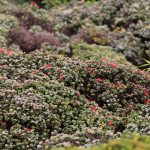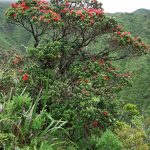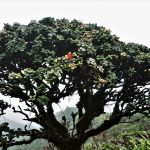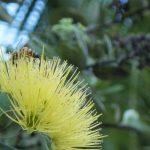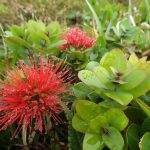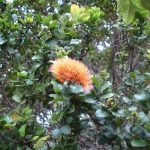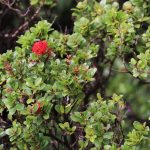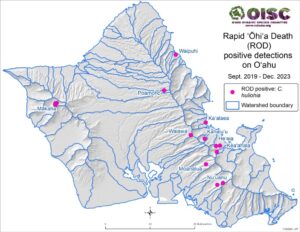ROD SYMPTOMS = BROWN LEAVES ATTACHED (by branch or entire crown)
- Slideshow of symptomatic ʻōhiʻa trees. These symptoms can be caused by a variety of issues. ROD can only be confirmed by a lab test of the wood.
- The entire crown of this ʻōhiʻa has turned brown. Notice the healthy ʻōhiʻa on either side for a comparison.
- Brown crown
- Brown crown. Though exhibiting ROD symptoms, after testing this tree did not have ROD. It most likely died to stress of intense landscaping near its trunk and roots.
- This brown branch is called “flagging”. OISC will sample the wood from the dead branch to see if ROD is present.
- Brown crown against a landscape.
HEALTHY ʻŌHIʻA TREES
- Slideshow of healthy ʻōhiʻa trees
- A very old, & healthy ʻōhiʻa
- Healthy ʻōhiʻa with its trademark silhouette
- Healthy ʻōhiʻa with its trademark silhouette
- Healthy ʻōhiʻa
- A large, healthy ʻōhiʻa
- Healthy ʻōhiʻa
- Healthy ʻōhiʻa with its trademark silhouette
- Yellow ʻōhiʻa blossoms are called “lehua mamo”
- Red ʻōhiʻa blossoms are the most common.
- ʻōhiʻa blossoms can be red, yellow or this salmon color.
- ʻŌhiʻa are a pioneer species, one of the first to grow on recent lava flow. Their roots break up the lava rock, creating space and soil for other plants to germinate…creating new forests.
- Healthy ʻōhiʻa
- Over 356 ʻōhiʻa trees have been sampled to test for the presence of ROD.
- Only 15 trees have tested positive for the less aggressive species of the ROD fungus, Ceratocystis huliohia.
- Of the 15 positive trees; 5 are residential locations, and 10 are wildland locations.
- There have been no detections of the very aggressive species on Oʻahu, Ceratocystis lukuohia.
HOW TO HELP PREVENT THE SPREAD OF ROD?
- Don’t injure ʻōhiʻa trees.
- Clean soil from shoes and tools and then spray with 70% rubbing alcohol if can.
- Don’t move ʻōhiʻa logs or plant parts.
- Don’t transport ʻōhiʻa inter-island.
- Wash any vehicles/bikes that have been off-road with high-pressure hose.
WHAT IS ROD?
Rapid ʻōhiʻa Death (ROD) is a fungal pathogen new to science and not seen before 2014. There are two (2) species of ROD:
- Ceratocystis lukuohia – VERY aggressive and rapid death as occurs in as little as two weeks.
- Ceratocystis huliohia – Less aggressive and death can take many months.
ROD QUICK FACTS:
- Symptoms of ROD are dead or dying ʻōhiʻa trees with brown leaves still attached.
- Both species of ROD present the same symptoms: brown leaves on branches or entire tree.
- ROD fungus lived INSIDE the tree, you cannot see it on leaves, branches or flowers.
- ROD enters the ʻōhiʻa tree through a wound…do not injure ʻōhiʻa trees.
- If you see suspect ROD, send photos to OISC via email: oisc@hawaii.edu or text to: 808-286-4616.
- You can also always report using the free smartphone app: 643PEST
A variety of things can kill ʻōhiʻa trees and we can’t know if it’s ROD unless we get a sample of the wood from inside the tree. You cannot see ROD on leaves or branches…it grows inside the sapwood. This is where the tree moves water around. When the fungus plugs up the sapwood, no water can be moved and the leaves turn brown.
ABOUT ʻŌHIʻA:
- ʻŌhiʻa is the dominant canopy forest tree.
- There are over 350 million trees across 800,000 acres on all the main Hawaiian Islands.
- ʻŌhiʻa is a keystone species.
- This means it is integral to the ecosystem and the services they provide like clean water, water capture, as well as flood and erosion control.
- ʻŌhiʻa is significant to Hawaiian culture.
- ‘Ōhiʻa is represented in numerous hula, moʻolelo, mele, and ʻoli. ʻŌhiʻa serve as the sacred kinolau (physical manifestations) of multiple Hawaiian deities
- There are five species of ʻōhiʻa in Hawaiʻi.
- They are all endemic to our state, meaning they are found nowhere else in the world. Two of those five are endemic to Oʻahu island.
HOW TO COLLECT & SUBMIT ʻŌHIʻA SAMPLES TO TEST FOR ROD – for Land Managers and Conservation Field Staff ONLY.
OISC and DOFAW are the primary organizations surveying and sampling for ROD on Oʻahu. We are limited with time and staff. Assistance from land managers and conservation field workers to collect samples from suspect trees is helpful. Collecting samples from dead/dying ‘ōhiʻa trees is easy and we can show you how to prepare your team to sample ʻōhiʻa suspect trees they may come across when working in the field.
We can “train the trainer”, showing you how to collect samples, properly decontaminate your tools and self, and properly submit your wood samples for testing. We sample at least once a month, so contact us via email to arrange your training: oisc@hawaii.edu.
Resources for how to collect & submit suspect ROD samples for land managers and field staff are available upon request. For downloadable guides, please email: oisc@hawaii.edu
**Due to the risk of contamination and spread during sampling, training is needed to collect ʻōhiʻa samples for testing. If you are a private landowner, contact OISC for a free test. Call/text: 808-286-4616 or email: oisc@hawaii.edu.
For more details about ROD and ʻōhiʻa, visit: www.rapidohiadeath.org
